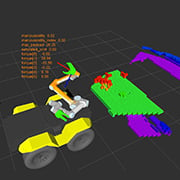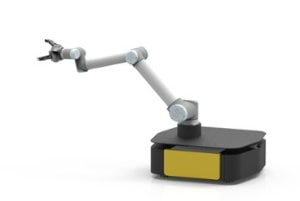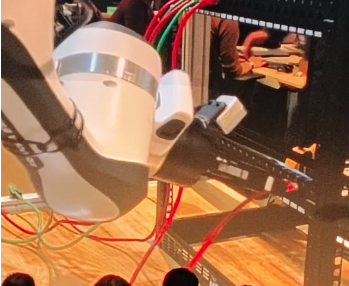Clearpath Mobile Manipulator to Automate your Warehouse

Posted on Jul 20, 2015 in Automation
4 min read time
As I was writing in a previous blog post, ''2015 Year of the Mobile Manipulator?'', we can see that several companies are promoting this new kind of robot. In fact, Clearpath Robotics just released this video of Ridgeback in a warehouse automation process. To shed some light on mobile manipulation, here is what it's all about.
Before going into an explanation, take a look at the Clearpath video, it's quite fun!
From an application standpoint, there are four general steps in this video: global task planning, the movement of the mobile platform, the grasping step and the release step. Each step has a direct impact on the efficiency and reliability of the robot.
Global Path Planning
So there are several points to identify here, first the robot has to plan the global task itself, in other words, locate itself and the object it is seeking, determine how it is going to get to the object, execute this without injuring anyone or crashing into anything, execute its collection program to grab the object, return to the start point or another point if this is the drop off point and release the object. These tasks can be broken down into separate modules with their individual programming algorithms, but quite impressive nevertheless!
Movement of the Mobile Platform
Since the robot is asked to go search for a given object, it knows where it has to end up. A simple algorithm will calculate the best way to get to the object and the robot will follow this path. However, as people or objects may be in the path of the robot on its way to its destination, it has to be able to avoid them. This is where the sensors Clearpath has integrated into Ridgeback come into play. As the sensors interpret what they see, they can detect objects and avoid them without stopping unless there is a danger of collision. As the robot knows its limitations, it can calculate if it can pass between two objects or not.

Grasp Planning
Once the robot arm is located in front of the object it is seeking, it has to pick it up. In comparison to traditional robotic applications, this application has a lot of uncertainties. In fact, the object has to first be located, then the robot has to plan the best way to grab it and finally it has to make sure it has a good grasp on it. All operations that seems intuitive for us, but that are quite complex for a robot.
First the vision system on the robot arm, locates the objects. The software then plans the best option for grabbing it and orients the robot arm and Gripper accordingly. The robot then approaches the object and grasps it. Thanks to object detection in the Gripper, the program has feedback about whether the object was successfully grabbed or not. The robot arm can then transfer the object into the bin and let it enjoy the ride.
So there are two main points to identify here, first the robot has to plan the task itself, in other words, locate the object and the nature of the object in direct relation to the position of the robot. Second the robot has to execute the task which has to be monitored either by the gripper sensors or by the vision system.
Release Planning
In this example, the drop planning is quite simple since it only releases the object to the worker, but in ''real life'' the robot might need to put the object in a precise spot like on the wheel axle directly. This is pretty much like the grasp planning process, but the vision system has to identify the receiving area and make sure the object can get to it and that the object really makes its way into the bin or the workers hands, if not, the whole operation fails. Which of course it doesn’t, as you can see by the video.

Hardware
Clearpath Robotics : Ridgeback
This mobile platform is small but rugged enough to do indoor or warehouse manipulation. Things such as ''Swedish'' wheels allow 3 degrees of freedom and different devices monitor its surroundings. The initial platform was designed to carry a Baxter robot, but Clearpath will pre-integrate Ridgeback with other platforms according to the user’s requirements. What you saw in the video incorporated a UR5 and Robotiq 3-Finger Gripper.
Universal Robots : UR5
The easy to recognize blue and gray/silver Universal Robots UR5 is used in this application because of its ability to work alongside humans without harming them, as well as the fact that it is easy to program and flexible. This robot arm can carry a 5 kg payload which means that it can carry a lot of diverse objects. Notice that Universal Robots also manufactures a UR3 (3 kg payload) and a UR10 (10 kg payload).
Robotiq : 3-Finger Adaptive Gripper
Our 3-Finger Adaptive Gripper is used in applications where a lot of flexibility is required. In the case of warehouse manipulation, a lot of different objects have to be handled. The position and orientation of the objects can be quite diverse, which requires a gripper that can adapt itself to the situation. This is why the 3-Finger Gripper has been chosen for this application.
Hopefully this gave you a better idea of the complexity that mobile manipulation can achieve. If you are not there yet, you may want to begin by integrating a robot in your shop! To do so, take a look at the link below.








Leave a comment